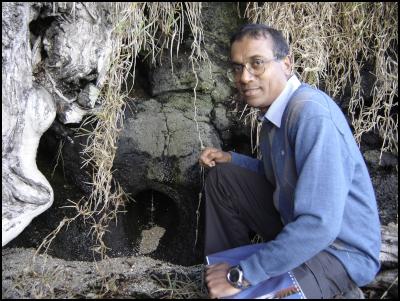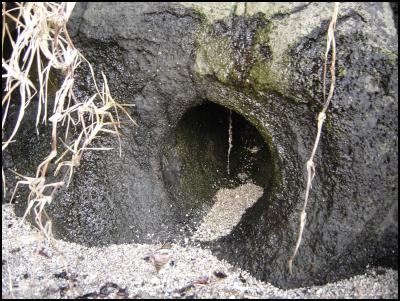Protecting North Shore City’s fossil forest
Protecting North Shore City’s fossil forest

North Shore City Council Wastewater Project Engineer, Lalith Fernando, examines a fossilised tree mould.Click for big version

Click for big version
Close up of fossilised tree mould.

Click for big version
The sewer line running along the Takapuna foreshore where the work is being done is a popular walkway.
Protecting North Shore City’s fossil
forest
May 31, 2006
One of North Shore City’s most significant geological features - a 200,000-year-old fossil forest - will get some TLC next week as part of the council’s project to protect Takapuna’s rocky foreshore.
Over time wave action has eroded the base of the foreshore creating a cavity and destabilising the rocks. This threatens the trunk sewer that runs along the shoreline, and the surrounding trees sculpted in solid lava.
North Shore City Council’s wastewater network projects manager, Dave Woods, says the repairs will prevent the sewer from damage and contaminating the beach.
“Project CARE makes beach water quality a priority, and upgrading our infrastructure will reduce the risk of pollution,” he says.
“By filling in the cavity and securing these rocks, we can prolong the life of the sewer, while also helping to preserve the ancient fossilised trees that create this unique coastline.”
According to well-known Auckland geologist Bruce Hayward, the Takapuna Reef Fossil Forest formed when lava from Pupuke volcano surged through a standing forest thousands of years ago. As the lava cooled around tree trunks, it solidified forming the hundreds of moulds now visible in the reef at the northern end of Takapuna Beach.
Mr Woods says all efforts are being made to ensure the repair work blends in with the coastline.
“The cavities will be filled with a specially coloured concrete that will be sculpted to look natural and match the surrounding landscape,” he says.
Dr Hayward says it is important to preserve these areas which make a significant contribution to the landscape character and geological history of the city.
“This is New Zealand’s only example of a fossil forest preserved in a lava flow and ranks among the best examples in the world,” he says.
“It’s great to see that people now recognise the educational, scientific and aesthetic values of Takapuna Reef’s fossil forest.”
The work will take place between Brett Ave and O’Neill’s Ave along the Takapuna foreshore. It is expected to start on June 6 and continue for up to four weeks.
ENDS


 Gordon Campbell: On The Making Of King Donald
Gordon Campbell: On The Making Of King Donald Ngati Kahungunu Iwi Inc: Kahungunu Submission Rejects The Regulatory Standards Bill In Its Entirety
Ngati Kahungunu Iwi Inc: Kahungunu Submission Rejects The Regulatory Standards Bill In Its Entirety Fire and Emergency NZ: Older People Are More Likely To Die In A House Fire This Winter - Check They Are Fire Safe Today
Fire and Emergency NZ: Older People Are More Likely To Die In A House Fire This Winter - Check They Are Fire Safe Today The Reserve Bank of New Zealand: Statement from RBNZ chair Neil Quigley about OIAs on Adrian Orr's resignation
The Reserve Bank of New Zealand: Statement from RBNZ chair Neil Quigley about OIAs on Adrian Orr's resignation Deep Sea Conservation Coalition: Protected Corals Destroyed In Six-Tonne Bycatch “Disaster” From A Single Bottom Trawl
Deep Sea Conservation Coalition: Protected Corals Destroyed In Six-Tonne Bycatch “Disaster” From A Single Bottom Trawl Aroturuki Tamariki: Report On Outcomes For Tamariki And Rangatahi Māori In The Oranga Tamariki System – A Story Of Consequence
Aroturuki Tamariki: Report On Outcomes For Tamariki And Rangatahi Māori In The Oranga Tamariki System – A Story Of Consequence Fire and Emergency NZ: Unsafe Driver Behaviour Putting Firefighters At Risk
Fire and Emergency NZ: Unsafe Driver Behaviour Putting Firefighters At Risk


